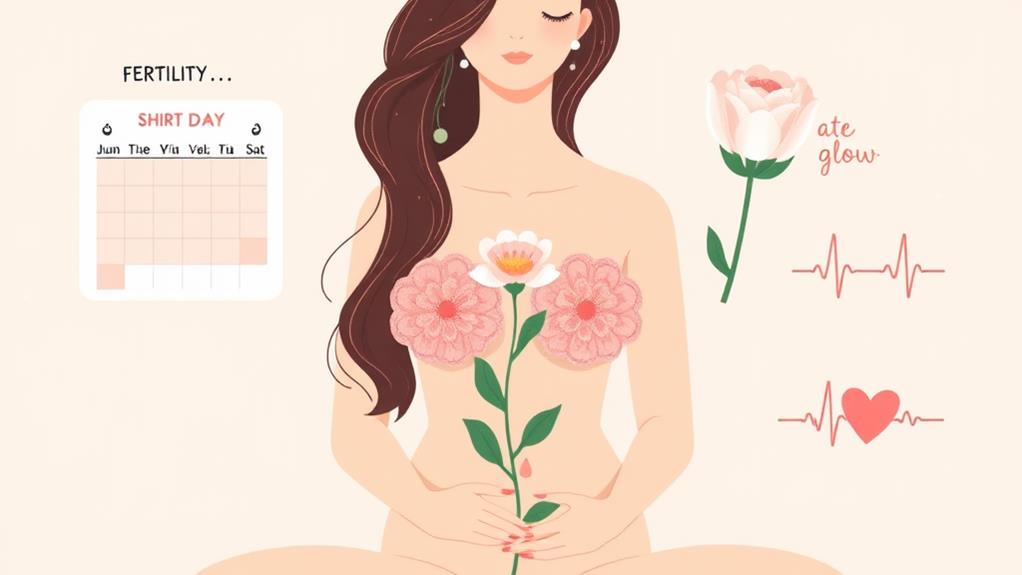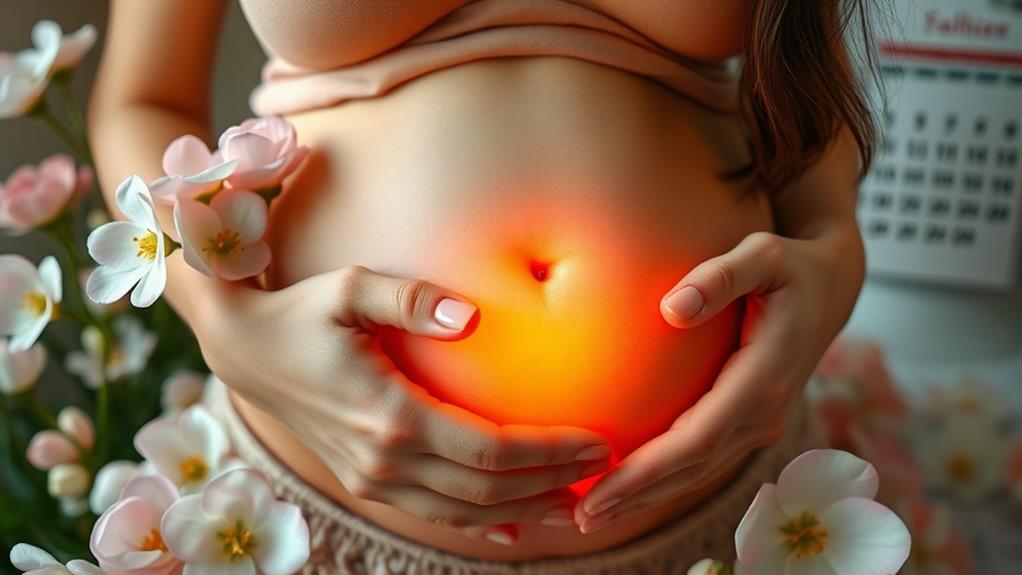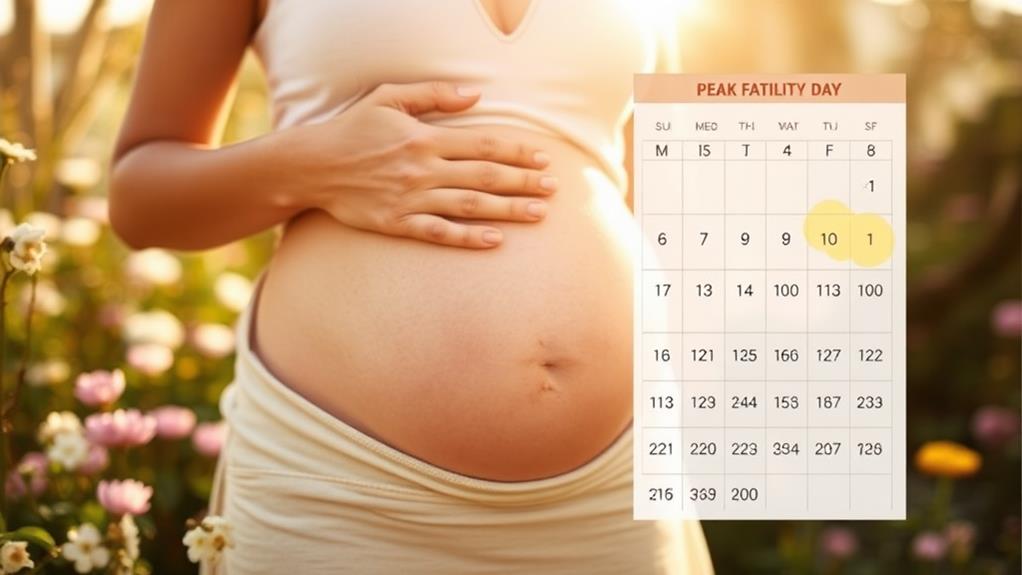Understanding your ovulation symptoms can significantly enhance your ability to pinpoint your most fertile days. You might notice changes like a rise in basal body temperature or shifts in cervical mucus, which can provide valuable insights into your cycle. Additionally, other subtle signs, such as increased libido or mild discomfort, can play a role. By tracking these indicators, you can better navigate your fertile window. But what specific methods can you use to ensure you're maximizing your chances? Let's explore the nuances of ovulation symptoms together.
Understanding Ovulation

Understanding ovulation is key to grasping your reproductive health. Ovulation is when a mature egg is released from an ovary, usually around day 14 of your menstrual cycle. But don't worry if your cycle isn't exactly 28 days; it can happen anywhere between days 11 and 21! This process is triggered by a surge in luteinizing hormone (LH), and the egg is ready for potential fertilization for about 24 hours.
Now, here's where the fertile window comes into play. It's a magical six-day period that includes the five days leading up to ovulation and the day of ovulation itself. During this time, your chances of getting pregnant are at their highest.
You might notice some signs of ovulation, like changes in cervical mucus, which can become slippery and stretchy. Some women even experience ovulation pain, a little twinge that reminds you something's happening.
Tracking your basal body temperature can also help pinpoint the timing of ovulation. So, pay attention to these clues, and you'll be better equipped to understand your reproductive health!
Key Ovulation Symptoms
During ovulation, your body can signal that it's ready for potential conception through several key symptoms.
First up, you might notice a rise in your basal body temperature, which can increase by about 0.5 to 1 degree Fahrenheit. This indicates that ovulation has occurred.
Next, pay attention to your cervical mucus; it changes to become clear, slippery, and elastic, much like raw egg whites. This helps sperm move more easily.
You may also feel Mittelschmerz, a mild pain or cramping on one side of your abdomen. It's a sign that your ovaries are working!
Another common symptom is a boost in libido, as your body naturally encourages you to seek out those fertile days.
Don't forget about breast tenderness, bloating, and mood swings, all linked to hormonal fluctuations during this phase.
These are signs of fertility and can help you identify when you're most likely to conceive.
By being aware of these ovulation symptoms, you can make the most of your fertile days and feel a little more in tune with your body.
Tracking Your Menstrual Cycle

Tracking your menstrual cycle is an empowering tool for anyone wanting to understand their body better. It all starts with noting the first day of your period, which helps you figure out your cycle length. For most people, ovulation happens around day 14 in a 28-day cycle, but cycle lengths can range from 21 to 35 days. So, don't worry if yours is different!
To find your fertile window, subtract 18 days from your shortest cycle and 11 days from your longest. This gives you a range of days when ovulation is likely to occur.
Keeping track of symptoms like changes in cervical mucus, mood swings, and even temperature can help you see the hormonal changes happening in your body.
Using cycle tracking apps makes this process even easier. They can automatically calculate your ovulation days and fertile window based on the data you input.
Plus, regularly observing patterns can help you spot any irregularities, making it easier to chat with a healthcare provider if you have concerns.
Basal Body Temperature Changes
One key indicator of ovulation is your basal body temperature (BBT), which can provide valuable insights into your cycle.
Before ovulation, you might notice a slight dip in your BBT. Then, after ovulation happens, your temperature usually rises by 0.4-1.0°F. This increase is caused by the hormone progesterone, which kicks in after the egg is released.
By tracking your daily BBT measurements, you can start to identify ovulation patterns over time.
It's best to take your BBT first thing in the morning, right before you get out of bed or do anything active. This helps ensure your readings are accurate.
Once you see a sustained temperature rise that lasts for at least three days, it's a good sign that ovulation has occurred. This can help you narrow down your fertile window, making it easier to plan or avoid pregnancy.
Cervical Mucus Patterns

Cervical mucus patterns are essential indicators of your fertility and can help you pinpoint when you're most likely to ovulate. Throughout your menstrual cycle, cervical mucus changes in texture and appearance.
As ovulation approaches, it becomes clear, stretchy, and slippery—kind of like raw egg whites! This transformation is due to rising estrogen levels, which peak just before ovulation, getting your body ready for fertilization.
During these fertile days, the amount of cervical mucus usually increases, providing a visual cue for you to identify your most fertile window. You can think of it as nature's way of waving a flag, saying, "Hey, it's time to make a baby!"
After ovulation, the cervical mucus thickens and becomes less abundant, thanks to a rise in progesterone. This change signals that your fertile window has closed.
Using Ovulation Predictor Kits
Understanding cervical mucus patterns gives you valuable insight into your fertility, but if you're looking for a more precise way to pinpoint ovulation, ovulation predictor kits (OPKs) are a great option.
These nifty kits detect the surge in luteinizing hormone (LH) that happens 24-48 hours before ovulation, signaling the start of your fertile window. You can find OPKs as easy-to-use urine tests at most stores.
To get the best results, it's super important to follow the testing instructions carefully. Testing at the same time each day, ideally in the afternoon or early evening, can give you the most reliable results since LH levels tend to peak then.
Remember, not all OPKs are equally accurate, so don't get discouraged if you don't see a surge right away!
Combining OPK results with other methods, like tracking your basal body temperature and cervical mucus, can really help you understand your individual ovulation patterns.
Additional Signs of Fertility

As you track your fertility, it's important to recognize that ovulation symptoms can extend beyond the obvious signs. You might notice some additional signs of fertility that are linked to hormonal changes in your body.
For instance, increased libido is common during your most fertile days, thanks to those hormonal shifts urging you to mate.
You could also experience breast tenderness or even swelling, which can happen as estrogen and progesterone levels fluctuate.
Keep an eye out for changes in your cervical mucus, too. Light spotting or a change in discharge color may indicate that ovulation is just around the corner.
Mood changes can sneak up on you during this time, making you feel more irritable or emotionally sensitive. It's all part of the hormonal rollercoaster!
And don't worry, you're not alone in this; many women experience these signs.
Tips for Enhancing Conception
Recognizing your ovulation symptoms is just one part of the journey toward conception. To boost your chances, tracking your menstrual cycle is key. Ovulation usually happens about 14 days before your next period, so having regular intercourse during your fertile window—the 5-6 days leading up to ovulation—can make a big difference.
Pay attention to your cervical mucus, too. When it gets clear, slippery, and stretchy like raw egg whites, it's a sure sign of ovulation, meaning you're at your most fertile.
Another helpful tip is to track your basal body temperature (BBT). A rise of 0.5-1°F after ovulation is a great confirmation that you've ovulated.
Don't forget about managing stress! High stress can mess with your hormones, so yoga, meditation, or even a brisk walk can help you relax.
Also, maintaining a healthy weight is important—aim for a Body Mass Index (BMI) between 18.5 and 24.9, as being underweight or overweight can impact your ovulation.

